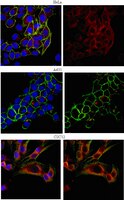Neurotrophin receptor p75 mediates the uptake of the amyloid beta (Aβ) peptide, guiding it to lysosomes for degradation in basal forebrain cholinergic neurons.
Ovsepian, Saak V, et al.
Brain Struct Funct, (2013)
2013
Afficher le résumé
A fascinating yet perhaps overlooked trait of the p75 neurotrophin receptor (p75(NTR)) is its ability to bind ligands with no obvious neurotrophic function. Using cultured basal forebrain (BF) neurons, this study demonstrates selective internalization of amyloid β (Aβ) 1-42 in conjunction with p75(NTR) (labelled with IgG192-Cy3) by cholinergic cells. Active under resting conditions, this process was enhanced by high K(+) stimulation and was insensitive to inhibitors of regulated synaptic activity-tetrodotoxin or botulinum neurotoxins (BoNT type/A and/B). Blockade of sarco-endoplasmic reticulum (SERCA) Ca(2+) ATPase with thapsigargin and CPA or chelation of Ca(2+) with EGTA-AM strongly suppressed the endocytosis of p75(NTR), implicating the role of ER released Ca(2+). The uptake of IgG192-Cy3 was also reduced by T-type Ca(2+) channel blocker mibefradil but not Cd(2+), an indiscriminate blocker of high voltage-activated Ca(2+) currents. A strong co-localization of IgG192-Cy3 with late endosome (Rab7) or lysosome (Lamp1) qualifier proteins suggest these compartments as the primary destination for internalized IgG192 and Aβ. Selective uptake and labeling of BF cholinergic cells with IgG192-Cy3 injected into the prefrontal cortex was verified also in vivo. The significance of these findings in relation to Aβ clearance in the cerebral cortex and pathophysiology of Alzheimer's disease is discussed. | 23716278
 |














